Everyone enjoys a nice break eating out with friends or family. But remember, food can get contaminated anywhere – so it’s important to observe that food safety practices are being followed – no matter who prepares the meal or where you eat it.
Although contamination of food can occur at any point from farm to table, restaurant food workers are a common source of foodborne illness.
Most of the food illness incidents are caused by the poor food safety practices of restaurant workers. The most common causes of outbreaks in restaurants are sick workers spreading their germs onto the food and touching the food with their bare hands.



Food Safety Training is Essential to Public Health
- Learn about proper hygiene, cross contamination, cold and hot food safety, foodborne pathogens, and best practices to prevent foodborne illness.
- Food Manager Training & ANSI Certification - $99.00
- Food Handler Training - only $7.00!
- HACCP Training: 16hr/4hr/1hr
- Food Allergy Training - $15.00
- Enter Promo "train10off" at Checkout
Food Contamination and Hazards
Food contamination refers to food that has been defiled by a harmful microorganism, toxin, substance, or object.
A food contaminant is any harmful or poisonous agent (biological, chemical, or physical) – that is not naturally inherent to the food itself – in an amount that has the potential to pose a threat to human health or cause illness.
Because food becomes hazardous by contamination, food contaminants are also referred to as food hazards. A hazard is any source of potential damage, harm, or adverse health effects on something or someone.
The types of food contamination and the associated food contaminants (hazards) are:
- Biological Contamination
Biological contamination includes food contaminants (hazards) such as: bacteria, viruses, and parasites. Bacteria and viruses are responsible for most foodborne illnesses and are the biggest threat to food safety. - Chemical Contamination
Chemical contamination includes food contaminants (hazards) such as: natural toxins (algae, fungi, molds, plants, allergens) and chemical contaminants (pesticides, industrial chemicals, cleaning and sanitizing agents, food additives, drugs, and other toxins).- Allergenic Hazards: Food allergens are a sub-category of natural toxins within chemical hazards. Some people are sensitive to certain proteins in foods. The 8 major food allergens include: milk, eggs, fish, crustacean shellfish (lobster, crab, shrimp), wheat, soy, peanuts, and tree nuts.
- Physical Contamination
Physical contamination includes food contaminants (hazards) such as: foreign objects which include glass, metal, plastic, bone chips, hair, insects, pest droppings, and other undesirable particles or objects.
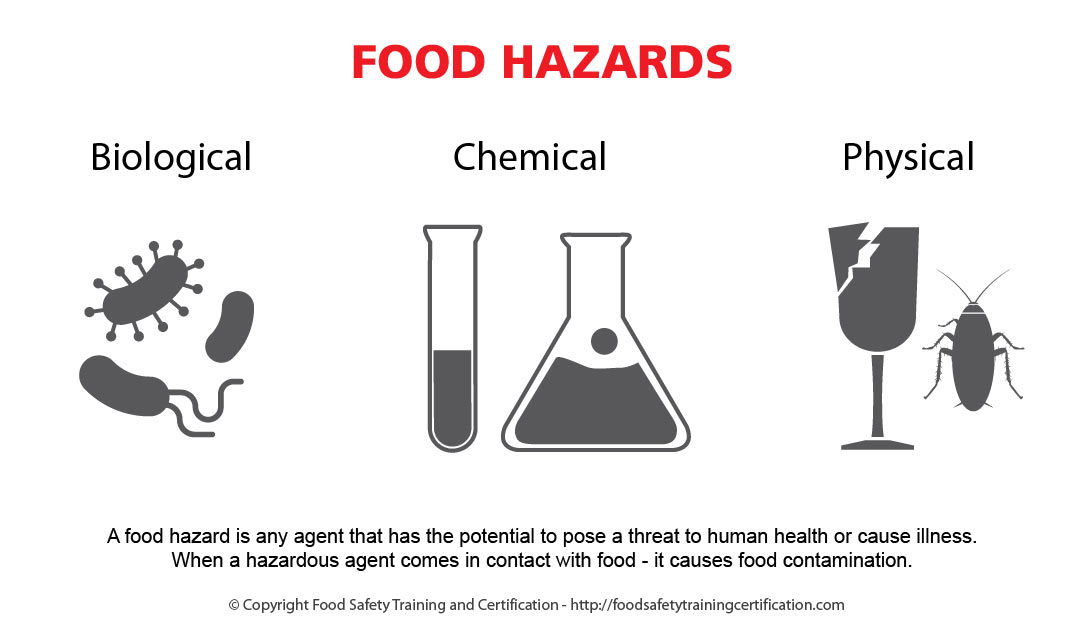


Cross-Contamination
Cross-contamination is a different type of food contamination. Cross-contamination is the process by which a harmful microorganism, toxin, substance, or object is unintentionally transferred from a person, surface, or object (usually because of improper or unsanitary handling procedures) to contaminate food and result in human illness.
What are the main causes of foodborne illness?
The CDC states that foodborne infections in the U.S. are most commonly caused by viruses (59%), bacteria (39%), and parasites (2%).
Among these pathogens (microorganisms that can produce disease), the top five that cause the most foodborne illnesses in the U.S. are:
- Norovirus
- Salmonella
- Clostridium perfringens
- Campylobacter
- Staphylococcus aureus (Staph)



Danger Zone (40°F – 140°F)
Bacteria grows rapidly between the temperatures of 40°F and 140°F, doubling in number in as little as 20 minutes. This range of temperatures is called the “Danger Zone.”
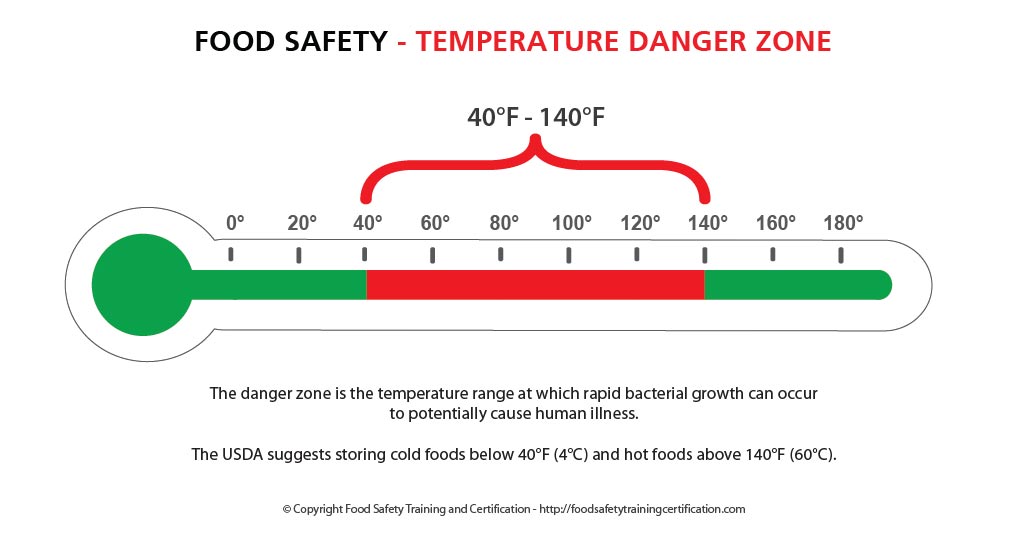


Two-Hour Rule
The absolute maximum time for leaving prepared foods at room temperature is 2 hours—including time for preparation, serving and eating. Discard any perishable foods left at room temperature longer than 2 hours. If you are eating outdoors at a picnic or cookout where temperatures are over 90°F, discard foods after 1 hour.



At Risk Groups for Foodborne Illness
Foodborne illness can affect anyone who eats contaminated food. However, certain populations are more susceptible to becoming ill with a greater severity of illness. These groups include:
- Pregnant women;
- Infants and young children;
- Older adults;
- People taking certain kinds of medications or with immune systems weakened from medical conditions, such as diabetes, liver disease, kidney disease, organ transplants, HIV/AIDS, or from receiving chemotherapy or radiation treatment.
Most people with a foodborne illness get better without medical treatment, but people with severe symptoms should see their doctor.
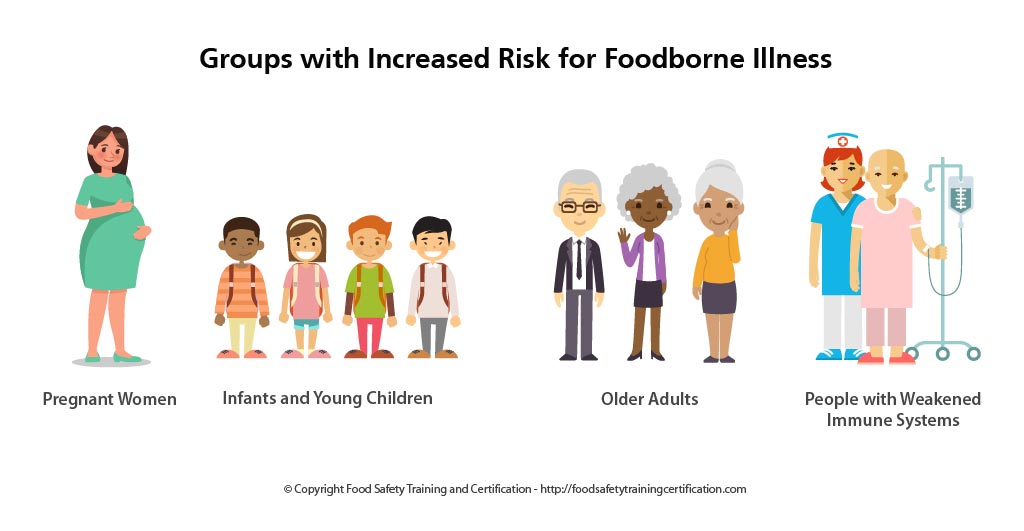


Food Safety Observations for Dining Out
Follow some basic food safety observations for dining out:
- Check Inspection Scores
Many state health departments make restaurant health inspection scores available on the web. Check the score before going to the restaurant or check when you get there. - Make Sure the Restaurant Is Clean
Confirm that restaurant tables, floors, and utensils are clean. If not, you may want to take your business elsewhere. - Check That Your Food Is Cooked Thoroughly
Meat, fish, poultry, and eggs should be cooked thoroughly to kill germs. If food is served undercooked or raw, send it back. - Properly Handle Your Leftovers
Taking your food to go? Remember to refrigerate within 2 hours of eating out. If food is left in a hot car or temperatures above 90ºF, refrigerate it within 1 hour. Eat leftovers within 3 to 4 days.
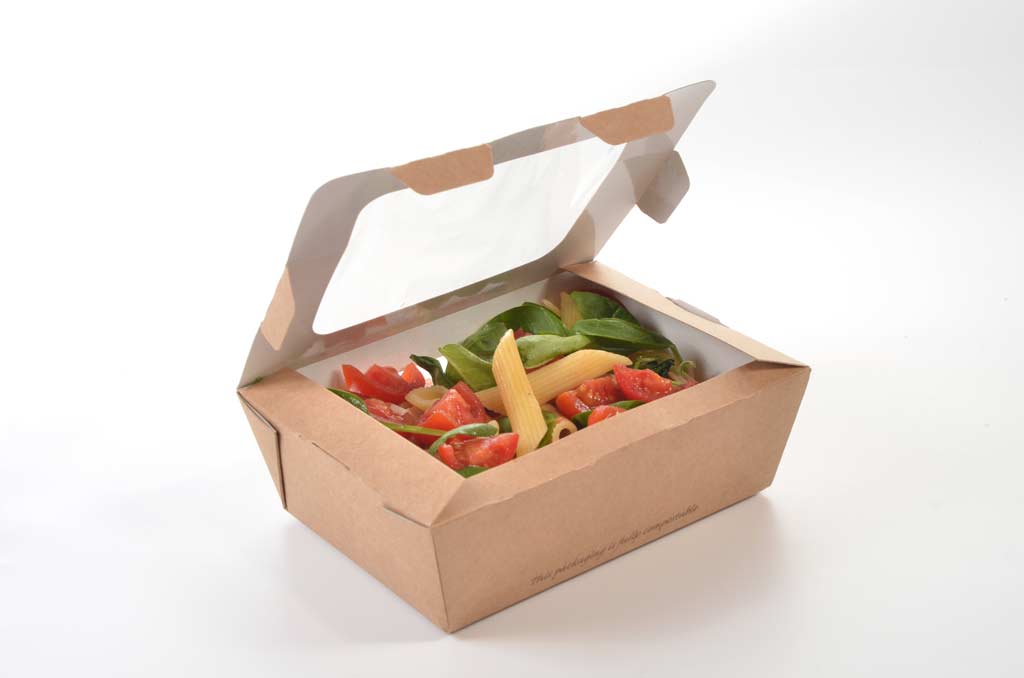


CDC Infographic (Protect Yourself When Eating Out):
- Download: Protect Yourself When Eating Out [PDF]
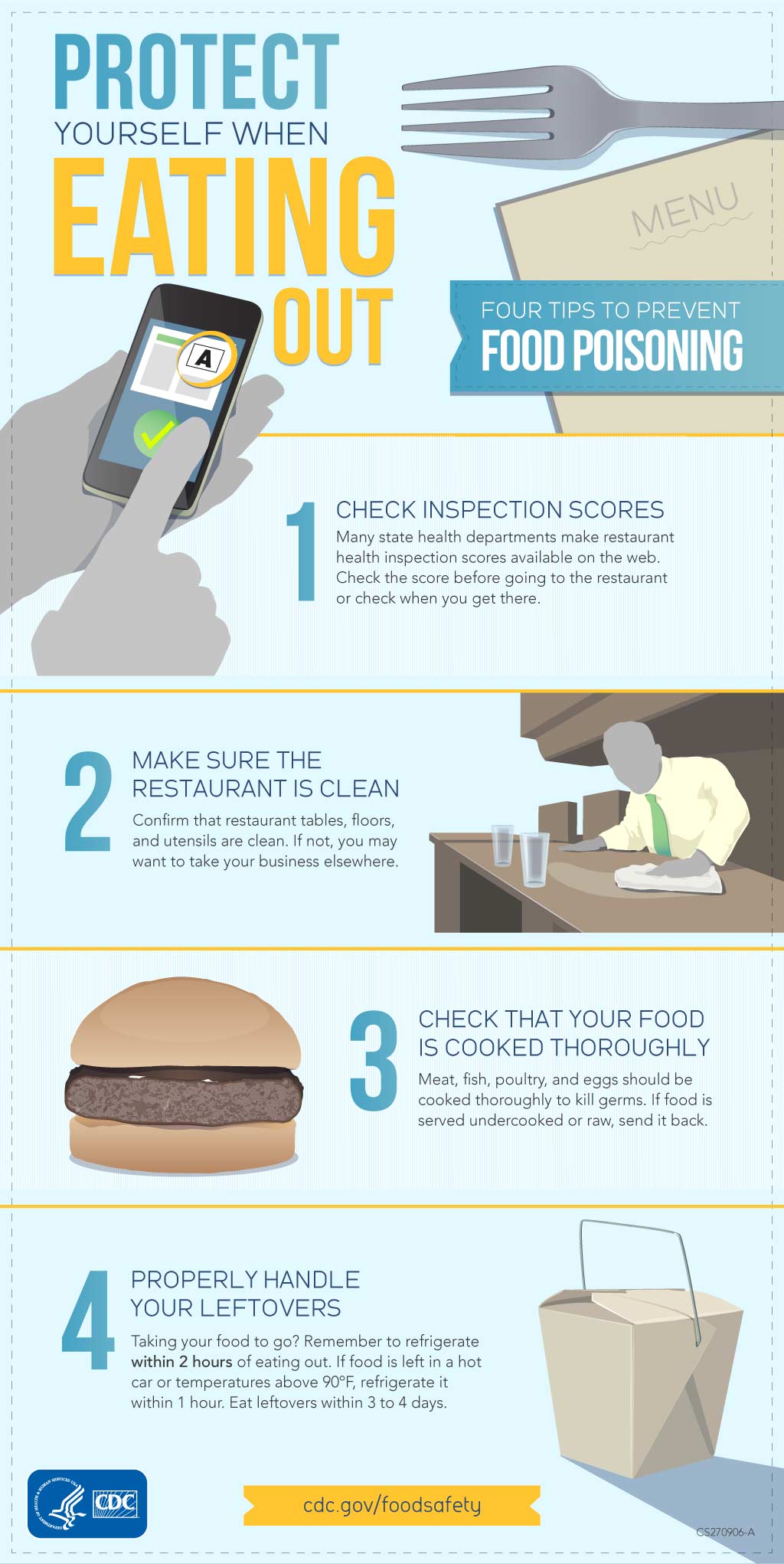


References
- Centers for Disease Control and Prevention (CDC). Burden of Foodborne Illness: Findings. Retrieved June 10, 2019, from
https://www.cdc.gov/foodborneburden/2011-foodborne-estimates.html - Centers for Disease Control and Prevention (CDC). Estimates of Foodborne Illness in the United States. Retrieved June 10, 2019, from
https://www.cdc.gov/foodborneburden/index.html - Centers for Disease Control and Prevention (CDC). Attribution of Foodborne Illness: Findings. Retrieved June 10, 2019, from
https://www.cdc.gov/foodborneburden/attribution/attribution-1998-2008.html - Emerging Infectious Diseases – January 2011; Vol 17 (1), pp. 7-20. Retrieved June 10, 2019, from
https://wwwnc.cdc.gov/eid/content/17/1/pdfs/v17-n1.pdf - Centers for Disease Control and Prevention (CDC). Foodborne Illnesses and Germs. Retrieved June 1, 2019, from
https://www.cdc.gov/foodsafety/foodborne-germs.html - Centers for Disease Control and Prevention (CDC). Study: Attribution of Foodborne Illness in the U.S. 1998-2008. Retrieved June 1, 2019, from
https://www.cdc.gov/foodborneburden/attribution/attribution-1998-2008.html - United States Department of Agriculture (USDA) – Economic Research Center (ERS). Quantifying the Impacts of Foodborne Illnesses. Retrieved June 1, 2019, from
https://www.ers.usda.gov/amber-waves/2015/september/quantifying-the-impacts-of-foodborne-illnesses/ - United States Department of Agriculture (USDA) – Economic Research Center (ERS). Cost Estimates of Foodborne Illnesses. Retrieved June 1, 2019, from
https://www.ers.usda.gov/data-products/cost-estimates-of-foodborne-illnesses/ - University of Nebraska-Lincoln. Institute of Agriculture and natural Resources. Food Poisoning (Foodborne Illness). Retrieved 23:38, July 7, 2019, from
https://food.unl.edu/food-poisoning-foodborne-illness - U.S. Department of Health and Human Services. National Institute of Diabetes and Digestive and Kidney Diseases. Foodborne Illnesses. Retrieved May 10, 2019, from
https://www.niddk.nih.gov/health-information/digestive-diseases/foodborne-illnesses - Minnesota Department of Health. Causes and Symptoms of Foodborne Illness. Retrieved June 10, 2019, from
https://www.health.state.mn.us/diseases/foodborne/basics.html - Wikipedia contributors. (2019, June 23). Foodborne illness. In Wikipedia, The Free Encyclopedia. Retrieved July 7, 2019, from
https://en.wikipedia.org/w/index.php?title=Foodborne_illness&oldid=903114088 - National Capital Poison Center. Food Poisoning. Retrieved July 7, 2019, from
https://www.poison.org/articles/2013-apr/food-poisoning - The Bad Bug Book (2nd Edition). U.S. Food & Drug Administration. Center for Food Safety & Applied Nutrition (2012). p.1.
https://www.fda.gov/media/83271/download






